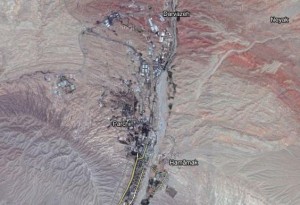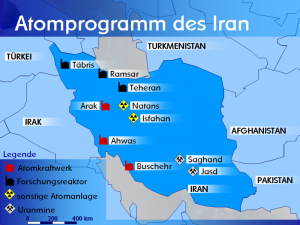Albright Discovers Puddles in Parchin

Google Maps image of Parchin, showing the dry landscape at over 5000 feet elevation. Note the extensive erosion patterns.
In March, Gareth Porter and I debunked claims that “diplomats” had fed to AP’s George Jahn. The diplomats asserted to Jahn that they had seen satellite photos depicting activity interpreted as attempts to clean the site at Parchin where they believe Iran has carried out work aimed at developing an explosive trigger device for a nuclear weapon.
Perhaps the biggest problem with the depiction of these activities as being aimed at cleaning the site is that, as I pointed out in the post linked above, it is virtually impossible to remove all traces of radioactive materials from a site where they have been used. The Iranians were very quick to point this out as well. No amount of cleaning will remove all of the residual radioactivity from the building or surrounding soil. I also pointed out in my post that no satellite photos purporting to show this cleaning activity had yet been made public.
Yesterday, David Albright and his Institute for Science and International Security dutifully stepped up to deliver what was intended as photographic proof. From Albright’s description:
The new activity seen in the satellite image occurred outside a building suspected to contain an explosive chamber used to carry out nuclear weapons related experiments (see figure 1). The April 9, 2012 satellite image shows items lined up outside the building. It is not clear what these items are. The image also shows what appears to be a stream of water that emanates from or near the building. Based on new information that the IAEA received, the Agency asked Iran to visit this building at the Parchin site, but Iran has not allowed a visit. IAEA Director General Yukiya Amano noted recently that the IAEA has “information that some activity is ongoing” at the Parchin site 1. When asked if he was concerned that these activities could be associated with cleansing the site, Amano replied, “That possibility is not excluded…We cannot say for sure because we are not there.” The items visible outside the building could be associated with the removal of equipment from the building or with cleansing it. The stream of water that appears to emanate from the building raises concerns that Iran may have been washing inside the building, or perhaps washing the items outside the building.
The idea that Iran would want to wash the building or its contents, presumably in order to remove radioactive contamination from trigger-building experiments, and then just allow the wash water to run onto the ground surrounding the building is laughable on its face. As I noted in my March post, the Iranians pointed out that radioactive contamination can’t be eliminated from a site where such work has been carried out. Of course they would know that merely rinsing some of the radioactive material into the ground surrounding the building would do nothing to hide it from the sensitive detection equipment IAEA would bring to an inspection.
There are two potential explanations for the water seen in the photo labeled April 9, 2012. Read more →

